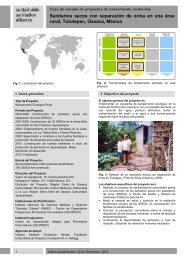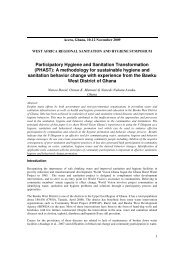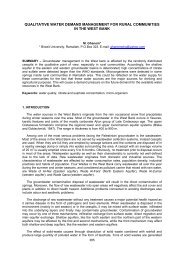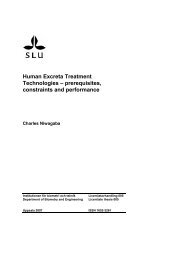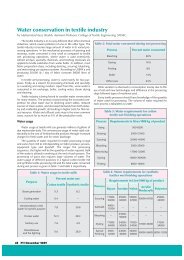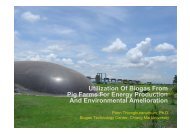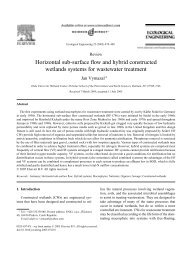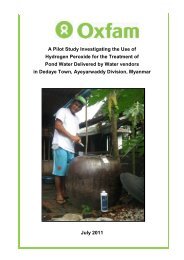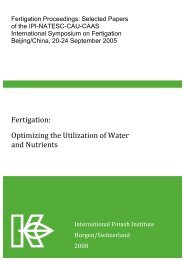Compilation of 13 factsheets on key sustainable sanitation ... - SSWM
Compilation of 13 factsheets on key sustainable sanitation ... - SSWM
Compilation of 13 factsheets on key sustainable sanitation ... - SSWM
Create successful ePaper yourself
Turn your PDF publications into a flip-book with our unique Google optimized e-Paper software.
ecovery <strong>on</strong> a global level (Rosemarin et al., 2009). It is<br />
estimated that the globally available phosphorus from urine<br />
and faeces could account for 22% <str<strong>on</strong>g>of</str<strong>on</strong>g> the total global<br />
phosphorus demand (Mihelcic et al., 2011).<br />
Nitrogen can be extracted from the surrounding air but the<br />
industrial Haber-Bosch process is energy-intensive and<br />
today str<strong>on</strong>gly based <strong>on</strong> limited fossil fuels. Furthermore,<br />
human activities now c<strong>on</strong>vert more nitrogen from the<br />
atmosphere into reactive forms than all <str<strong>on</strong>g>of</str<strong>on</strong>g> the earth´s<br />
terrestrial processes combined (reactive nitrogen is<br />
amm<strong>on</strong>ia, amm<strong>on</strong>ium, nitrate, nitrite and nitrous oxides, i.e.<br />
NO and NO2) (Gruber and Galloway, 2008). This is four<br />
times the rate proposed as the planetary boundary for<br />
human modificati<strong>on</strong> <str<strong>on</strong>g>of</str<strong>on</strong>g> the nitrogen cycle, in order to avoid<br />
large-scale ecological impacts, such as oceans becoming<br />
eutrophic due to nitrate (Rockström et al., 2009).<br />
This results in a triple driver for treated excreta use in<br />
agriculture in terms <str<strong>on</strong>g>of</str<strong>on</strong>g> nitrogen – to reduce fossil fuel use,<br />
reduce emissi<strong>on</strong>s <str<strong>on</strong>g>of</str<strong>on</strong>g> gases resp<strong>on</strong>sible for climate change<br />
and to reduce the input <str<strong>on</strong>g>of</str<strong>on</strong>g> reactive nitrogen in ecosystems.<br />
Another essential resource in food producti<strong>on</strong> is water.<br />
Agriculture is a water intensive process and c<strong>on</strong>sumes 70%<br />
<str<strong>on</strong>g>of</str<strong>on</strong>g> the total water withdrawn globally (FAO, 2011). The<br />
supply and availability <str<strong>on</strong>g>of</str<strong>on</strong>g> water is increasingly diminishing<br />
and is unevenly distributed globally. Already today, large<br />
parts <str<strong>on</strong>g>of</str<strong>on</strong>g> Asia, Africa and the Middle East face either<br />
physical or ec<strong>on</strong>omic water scarcity.<br />
Envir<strong>on</strong>mental c<strong>on</strong>sequences<br />
As urbanisati<strong>on</strong> has outpaced sanitati<strong>on</strong> infrastructure in<br />
many countries, today <strong>on</strong>ly a small fracti<strong>on</strong> <str<strong>on</strong>g>of</str<strong>on</strong>g> human<br />
excreta receives appropriate treatment, and generally<br />
resource recovery is not included. Cordell (2009) estimated<br />
that <strong>on</strong>ly 10% <str<strong>on</strong>g>of</str<strong>on</strong>g> nutrients in excreta return to arable soil.<br />
The disposal oriented sanitati<strong>on</strong> systems together with<br />
c<strong>on</strong>tinuous and excessive use <str<strong>on</strong>g>of</str<strong>on</strong>g> synthetic fertilisers <strong>on</strong><br />
farmlands can lead to serious envir<strong>on</strong>mental c<strong>on</strong>sequences<br />
such as eutrophicati<strong>on</strong> <str<strong>on</strong>g>of</str<strong>on</strong>g> surface waters, dead z<strong>on</strong>es al<strong>on</strong>g<br />
coastal estuaries and high nitrate c<strong>on</strong>centrati<strong>on</strong>s in<br />
groundwater with a negative impact <strong>on</strong> human health.<br />
Although in c<strong>on</strong>venti<strong>on</strong>al agriculture the loss <str<strong>on</strong>g>of</str<strong>on</strong>g> the most<br />
important macr<strong>on</strong>utrients is being compensated through<br />
applicati<strong>on</strong> <str<strong>on</strong>g>of</str<strong>on</strong>g> synthetic fertilisers, these fertilisers cannot<br />
replace the loss <str<strong>on</strong>g>of</str<strong>on</strong>g> organic matter, microorganisms and<br />
many micr<strong>on</strong>utrients equally important for fertile top soils. In<br />
many parts <str<strong>on</strong>g>of</str<strong>on</strong>g> the developing world the “mining” <str<strong>on</strong>g>of</str<strong>on</strong>g> soil<br />
nutrients is severe and crop yields are falling, as nutrients<br />
removed by the crops are <str<strong>on</strong>g>of</str<strong>on</strong>g>ten not replaced.<br />
Health impacts <str<strong>on</strong>g>of</str<strong>on</strong>g> undernutriti<strong>on</strong><br />
Undernutriti<strong>on</strong> causes weakness and fatigue, inhibits<br />
mental and physical development particularly in children<br />
(where it also causes stunting), and makes people<br />
susceptible to other fatal diseases such as pneum<strong>on</strong>ia and<br />
diarrhoea. In fact, it is estimated that the underlying cause<br />
for around <strong>on</strong>e third <str<strong>on</strong>g>of</str<strong>on</strong>g> all deaths <str<strong>on</strong>g>of</str<strong>on</strong>g> children under five<br />
years old is undernutriti<strong>on</strong> 2<br />
. Children and adults who are<br />
2<br />
See also www.childinfo.org/undernutriti<strong>on</strong>.html<br />
suffering from diarrhoea and intestinal worm infecti<strong>on</strong>s like<br />
ascaris, trichuris and hookworm obtain fewer calories from<br />
the food they eat. See for example DFID (2009) and<br />
Humphrey (2009) for more informati<strong>on</strong> <strong>on</strong> these health<br />
issues.<br />
Productive sanitati<strong>on</strong> could lead to higher crop yields,<br />
leading to less undernutriti<strong>on</strong> and hence less susceptibility<br />
for disease, growth stunting in children and death. In<br />
additi<strong>on</strong>, preventing diseases caused by lack <str<strong>on</strong>g>of</str<strong>on</strong>g> sanitati<strong>on</strong>,<br />
such as diarrhoea and helminth infecti<strong>on</strong>s, would lead to a<br />
more efficient use <str<strong>on</strong>g>of</str<strong>on</strong>g> available nutrients in food.<br />
3 The historical link between sanitati<strong>on</strong> and<br />
agriculture<br />
Food producti<strong>on</strong> is historically linked with using liquid and<br />
solid waste from human settlements in agriculture. In former<br />
centuries the removal <str<strong>on</strong>g>of</str<strong>on</strong>g> organic matter and nutrients from<br />
the soil through harvested crops was compensated through<br />
applicati<strong>on</strong> <str<strong>on</strong>g>of</str<strong>on</strong>g> animal manure, human excreta, compost or<br />
l<strong>on</strong>g fallow periods (see Lüthi et al., 2011). Only after the<br />
introducti<strong>on</strong> <str<strong>on</strong>g>of</str<strong>on</strong>g> phosphorus mining in the mid 19 th century,<br />
and industrial amm<strong>on</strong>ia producti<strong>on</strong> at the beginning <str<strong>on</strong>g>of</str<strong>on</strong>g> the<br />
20 th century, it became the prevailing practice to replace<br />
nutrients removed with the harvest from the soil and the<br />
additi<strong>on</strong> <str<strong>on</strong>g>of</str<strong>on</strong>g> human excreta with synthetic fertilisers.<br />
In the same era water based sanitati<strong>on</strong> systems with flush<br />
toilets and sewers were installed as a resp<strong>on</strong>se to the acute<br />
health crisis in large cities at that time. Although these new<br />
sanitati<strong>on</strong> systems did improve public health at that time<br />
significantly, they also c<strong>on</strong>tributed to polluting water<br />
resources and broke nutrient cycles.<br />
The idea that human excreta is a waste product without a<br />
useful purpose is a modern misc<strong>on</strong>cepti<strong>on</strong>: pits, water<br />
bodies and landfills are used nowadays as sinks for<br />
nutrients, organic matter and pathogens.<br />
4 Ec<strong>on</strong>omic implicati<strong>on</strong>s<br />
A high percentage <str<strong>on</strong>g>of</str<strong>on</strong>g> the populati<strong>on</strong> in areas affected by the<br />
sanitati<strong>on</strong> crisis carry out subsistence farming (IAASTD,<br />
2009), and struggle to maintain an income for feeding their<br />
families. Workdays and income w<strong>on</strong> through improved water<br />
and sanitati<strong>on</strong> services are thereby also a c<strong>on</strong>tributi<strong>on</strong> to<br />
food security.<br />
Many farmers are nowadays facing higher prices <str<strong>on</strong>g>of</str<strong>on</strong>g><br />
fertilisers, due to increasing demands, higher energy and<br />
transport costs as well as rising producti<strong>on</strong> costs (IWMI,<br />
2011). Food and fertiliser prices have been particularly<br />
unstable since the beginning <str<strong>on</strong>g>of</str<strong>on</strong>g> 2008 (see Figure 2). When<br />
fertiliser prices rise, developing countries which are<br />
dependent <strong>on</strong> fertiliser imports for agricultural producti<strong>on</strong> are<br />
particularly vulnerable. Poor infrastructure and high costs <str<strong>on</strong>g>of</str<strong>on</strong>g><br />
transport, particularly to remote areas, adds to the problem<br />
and further increases the local market prices for synthetic<br />
fertilisers.<br />
Synthetic fertilisers are <str<strong>on</strong>g>of</str<strong>on</strong>g>ten not affordable for small-scale<br />
farmers in developing countries unless they are subsidised.<br />
Productive sanitati<strong>on</strong> and the link to food security: Working Group 5 - page 2<br />
Productive sanitati<strong>on</strong> and the link to food security: Working Group - page 2



